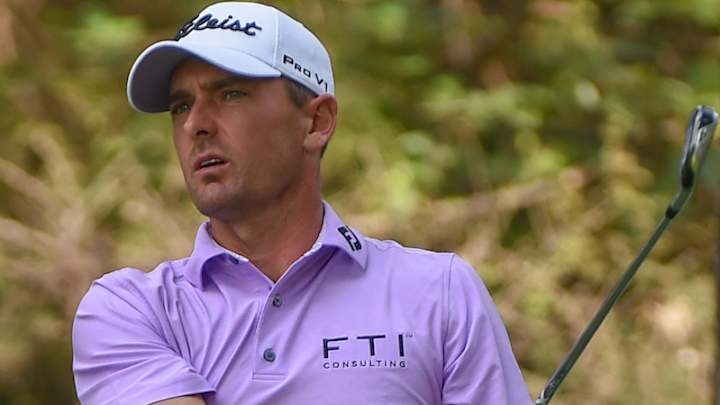20 years later, Howell faces a different game

SEA ISLAND, Ga. – Golf is different now. It’s bigger, it’s richer and it covers the planet. Thank you, Tiger Woods.
Hey, golf is even in the Olympics. Thank you again, Tiger Woods.
But is golf better now? I hate to comment (but I will, of course).
Golf always has been full of old codgers telling young players how everything was better when they were young – gasoline cost a quarter a gallon; a great car could be had for under two grand; greens were so slow that you had to make a shoulder turn on a long putt; and a persimmon driver required skill, because if you didn’t find the sweet spot, you lost 25 yards (off of a mighty 275-yard blast for a stud pro, 240 for a stick amateur) and the ball’s soft cover and liquid center would make it curve like a banana in either direction.
I don’t want to be that guy, but I do remember (but don’t long for) the time when 300-yard drives were rare events reserved for kings of golf such as Arnie and Jack, or big bashers such as Mike Souchak and George Bayer. (Haven’t heard of those two? Think John Daly without the issues.)
I won’t be the geezer who chides others for not removing their caps in restaurants, clubhouses and elevators, just as I won’t diss golf as we now know it. I’ve learned one important thing: Time doesn’t march on; it actually accelerates.

I blinked and Charles Howell III turned 40 a few moments after he arrived on tour … 20 years ago. Time is sneaky, I’m telling you. Don’t turn your back on it, because if you do, your mirror might turn full of wrinkles.
Howell was a wunderkind from Oklahoma State University who was unfortunately touted as a next Tiger Woods type when he first came out in 2000. He was no Next Tiger. No one would or could be. But Howell has three victories, including last year’s RSM Classic; 16 runner-up finishes and $39.5 million in winnings. Only a handful of players wouldn’t trade for that.
Sure, Howell would have liked to have won more, and he surely expected better 20 years ago, but last year’s RSM Classic reminded him how blessed he’s been and how difficult it is to win. He won in a playoff against Patrick Rodgers, a young gun like Howell once was. Blink!
Howell remembers his early days on tour. He was a David Leadbetter student, and he recalls watching Nick Price and Nick Faldo, two of Lord Lead’s best clients, on the practice range hitting 3-irons 205 yards at a target. Some were baby fades, some were draws, some were straight balls, some flew high and landed soft. The two Nicks were ball-striking Picassos.
That style of golf is gone, along with the 205-yard 3-iron. Two hundred and five yards? Hmm, gimme the 7-iron, caddie – or should I just step on an 8?
“David would say, ‘Look, Charlie, they [Price and Faldo] are really great iron players,’ and they were; it was super impressive,” Howell said Wednesday after his RSM Classic pro-am round. “But how the game has changed now is, go watch Rory McIlroy and Dustin Johnson and Brooks Koepka hit drivers, and watch Jordan Spieth putt, and find a way to do that. That’s the reality of it.”
Golf has changed. Maybe evolved is a better description. Iron play is important, just not as important as it used to be.
“I would say, more than ever, the driver and the putter have become golf,” Howell said. “What’s replaced a great iron player is maybe a guy who drives it great and putts it great. If there was a kid out there who wants to play professional golf, I would say, Learn to hit it as far as you can, and putt all the time.”
That is modern golf in a two-piece, solid-core nutshell. Power always has been an advantage, however. Even Bobby Jones could hit that nugget farther than most competitors back in golf’s prehistoric days.
“Let’s go back to Jack Nicklaus. Jack was the longest,” said Davis Love III, the tournament host for the RSM Classic. “There weren’t that many guys like that. Then in my generation, there were four or five or seven guys who were super long. Now, there are a hundred guys who are super long, and you have to have all the other aspects, too.
“Yeah, the game’s different, but it’s still the same. You have to have the power. You have to hole the putts. You have to hit the fairways. You just have more guys than ever playing Jack Nicklaus’ game.”
Today’s players – even those competing below the PGA Tour – have more-complete, better-rounded games than ever before.
Nicklaus had a poor wedge game, something that cost him the 1971 U.S. Open at Merion in a playoff with Lee Trevino when Nicklaus left one shot in the bunker and chunked a pitch shot. Nicklaus worked with Phil Rodgers to improve his short game later in his career, but it hadn’t been a priority because Nicklaus didn’t miss many greens. And even if he did, his power turned par 5s into two-putt birdie holes for him, and it usually didn’t cost him.
Love witnessed Q-School recently (the modern Q-School, to qualify for the Korn Ferry Tour – another change that might not be progress) with his son, Dru, and was impressed with the quality of play.
“You used to be able to get away with it if you didn’t do well in one aspect of your game,” Love said. “I came out of North Carolina as a ball-striker. I could hit it really, really good, and I got on tour with that. If I came out now with the game I had then, I probably wouldn’t make it through Q-School because I couldn’t chip and putt. You can’t just be a ball-striker now. You have to have every aspect to be competitive.”
You’ve heard this all before. Metal woods add distance and are more forgiving; the ball flies straighter and longer; shaft technology has been revolutionary; video instruction has been a game-changer; laser rangefinders and GPS devices have made the game more precise. Hole locations are tougher and courses grow longer, yet scores keep inching lower.
Golf is not your grandfather’s game, but what sport is? Three yards and a cloud of dust was still a viable strategy in college football into the mid-1970s, for instance. How’s that looking now?
What’s jarring is that golf is so different even from what it was only 20 years ago. Howell was still young then, and I still wasn’t officially old yet.
It seems like yesterday, but it wasn’t. (I looked it up to make sure.)
Golf is different. Is it better? My head says no, but my heart says it doesn’t matter. Just enjoy the game. Time will change it, along with everything else in the world, soon enough.
